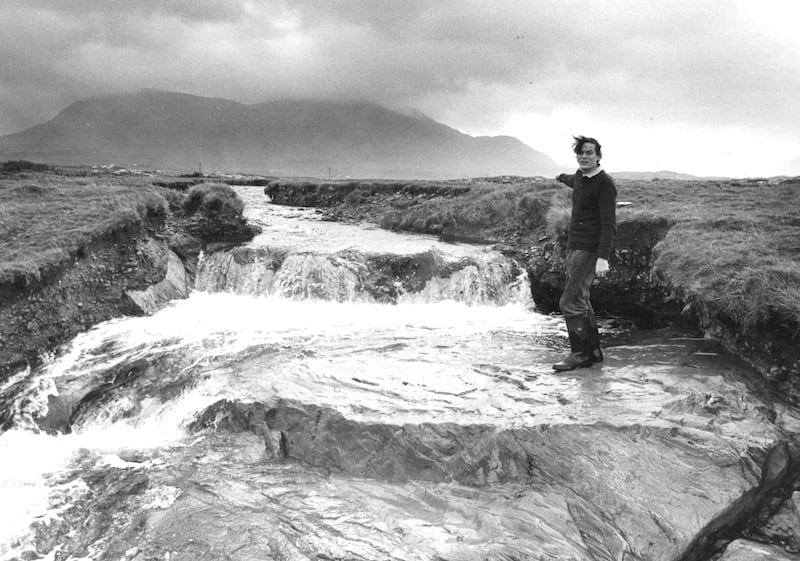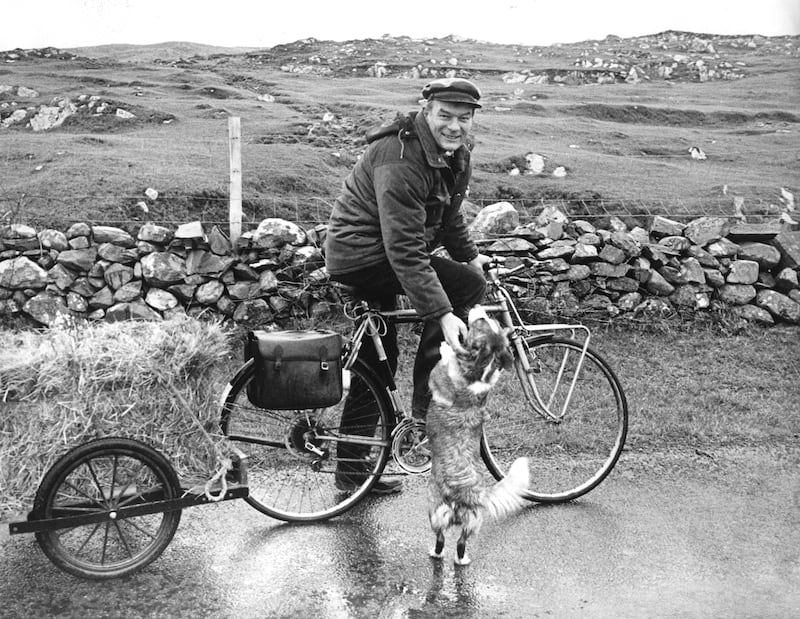Michael Viney’s first Another Life column appeared in The Irish Times more than 45 years ago, in October 1977. It was a dispatch from his family’s new home on the west coast of Ireland (from where Michael’s wife, Ethna, also wrote an Irish Times column, Eye on Nature, for 33 years). We reproduce it here to help mark, with the publication of Michael’s final column today, the conclusion of a remarkable career.
Another Life by Michael Viney
Saturday, October 8th, 1977
Michael Viney, RTÉ producer and former Irish Times journalist, and his wife Ethna, editor of Technology Ireland, have left public service jobs and sold their Dublin home to live with their eight-year-old daughter in a cottage in southwest Mayo. In Another Life, which will appear regularly, he reports on a change of lifestyle of a kind which many city people have at least considered.
Looking for the germ of it, the fatal nudge, I’d settle for the day the local JCB bit deep into the meadow and came up with jaws full of dark, sandy loam. Up to that moment, our cottage in the West was just the traditional perk of a Dublin professional family; there for a Friday-night dash once a month, for scythe-and-Snowcem holidays, and for ultimate, enfeebled, retirement. The land that came with the house, a generous Irish acre sloping towards the sea, had been just a part of the view, grazed by the neighbours’ sheep and by the finches and linnets that flocked to the thistles in autumn. We thought it must surely be lean land, here on a hillside of boulders and streams; a field scarcely worth the fencing.
The digger, trenching for a tank, proved us wrong. The soil was deep, and as clean and crisp in the hand as any potting mixture. It dared us not to wait until we were too old to work it.
READ MORE
I thought of this last week, as I began to lift what promises to be some seven or eight tons of potatoes, spilling from the ridges in mocking abundance. In any other year they would have paid for the fencing and more besides; it was just bad luck to hit the wrong end of the see-saw. So we shall eat what we can, save the best for seed, and get pigs to eat the rest. Somewhere in those CIÉ tea chests is a book on curing your own bacon, as there is on most of the contingencies of the self-sufficient life.
Once countenanced at all, the idea of this move promoted itself with a fine disregard of other events in our lives. It fed on our belief that anyone can do almost anything, given the will, the muscle and the right advice. As, tacitly, “if” became “when”, we rummaged through the options in setting up a homestead of frugal comfort.
It was during this process that we found we had become part not merely of a trend but of a whole international subculture.

There was a time when a move like ours was merely the folly of middle-aged romantics. But that was before the energy crisis and the Club of Rome, before Ralph Nader and Buckminster Fuller, before journals such as Undercurrents and the Ecologist and compendia of plain-man’s technology, before organic gardening, macrobiotics and the herbalist revival.
Self-sufficiency today amounts to much more than one would judge from The Good Life on television, fun though the series may be. It goes way beyond growing your own courgettes and brewing your own beer. At the ultimate, it experiments with “alternative” social groupings and “alternative” technologies exemplified by windmill and solar power and backyard hydroponics. Far from exalting the noble savage or trying to get back to nature by ignoring technology, it tries to demystify it, and bring it under domestic or communal control. Having a deep-freeze is quite respectable, but running it off a windmill would earn us extra points.
So long as we’re allowed to keep a sense of humour and don’t have to wear sandals carved from tractor tyres as a mark of the truly, truly self-sufficient, we are happy to follow the way and the light
Like it or not, therefore, we find ourselves apprenticed to a movement of protest against waste and consumerism, energy monopolies, junk foods, the rape of earth and sea and the galloping cancer of the city. And so long as we’re allowed to keep a sense of humour and don’t have to wear sandals carved from tractor tyres as a mark of the truly, truly self-sufficient, we are happy to follow the way and the light.
The committed alternative technologist would be ecstatic at our location – not for its views of mountains and sea but for its mean annual wind speed (among the highest in Ireland), its hours of sunshine (like those of the islands) and for the stream that runs beside the house. Technologists may deal in averages; we have seen the extremes and found them frightening.
There is, for example, a special menace in the wind from Mweelrea, the great pillared mountain that lifts our morning sun. The gales from the Atlantic may lean upon us until the walls creak, but the wind from Mweelrea, curling around the summit, slams the townland with a roundhouse punch. Until last month, I had thought that the reinforcing storm bars I had made to back the bigger window panes could at least stay down for the summer, but a sudden storm from Mweelrea had me scrambling for the timber in the middle of the night, screwing the bars into place against glass that was bowing like taut canvas. What would happen to a windmill in stresses like that, self-feathering or not? We may yet decide to find out, but shall want to be very certain what we are playing with.
The stream brings us water from the high ridge to the north. It looks tame enough in dry weather, muttering along in its own little glen and ducking out under the fuchsia: one might think of damming it for a trout pond or using it to drive a modest waterwheel. But we have seen it in quite a different form, swollen by freak rains into a foaming torrent yards across. No weir or sluice or fingerlings would have survived that roaring night, as bridges all along the road were smashed or swept away.
A violent coastline, then, given to sudden convulsions of weather. All through these shimmering September weeks the currach ought to have been out there fishing for the freezer, not lying idly here inside the gate. But until I have the strength and skill to manage the canoe, even with an outboard, there could be no question of setting to sea alone. It is capital equipment and its turn will come.

One of the reasons for changing our lives was to shape a better balance between the mental and the physical, and we have left it quite late enough to give these city bodies not mere agility, but solid strength and stamina as well. We shall have to be patient about it. But those who see us as “retiring” should try humping sacks of potatoes, cement and lime. I do have a cultivator, a 7hp brute, but its very effectiveness lies in its weight: it does twenty times the work in a day that I could manage with a spade, but to control it is like driving a chariot in Ben Hur.
So we are not retiring, nor are we “opting out” if that means a social withdrawal. This townland is a community, all the more tightly knit for being remote. The nearest small town is ten miles away, the nearest market town twice that. In such a location, you don’t hold aloof from your neighbours and then expect help in a crunch.
In this first column, I have tried to give the feel of what we’re about without getting too specific. We’re not playing at it, but we appreciate our privilege in having portable skills such as journalism, to help with some kind of cash flow. The social “movement” I have sketched in is real enough, if somewhat new to Ireland, and just might, in its essentials, prove the first true subversion since Marx. It offers a wider context for what will otherwise be our fairly straightforward attempts at self-sufficiency, and at integration into country life.
Next week, I’ll introduce the bees.
You can read Michael Viney’s final Another Life column here



















